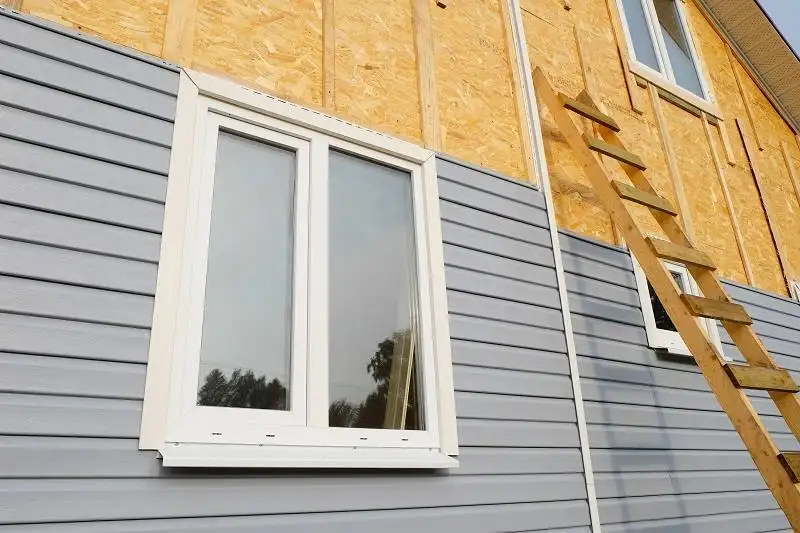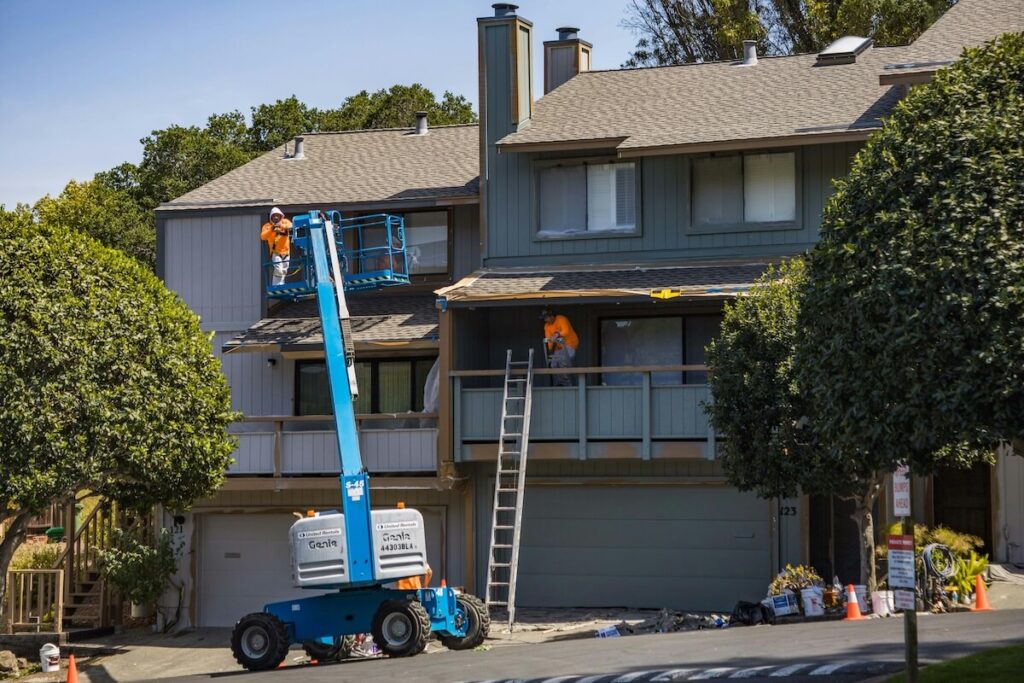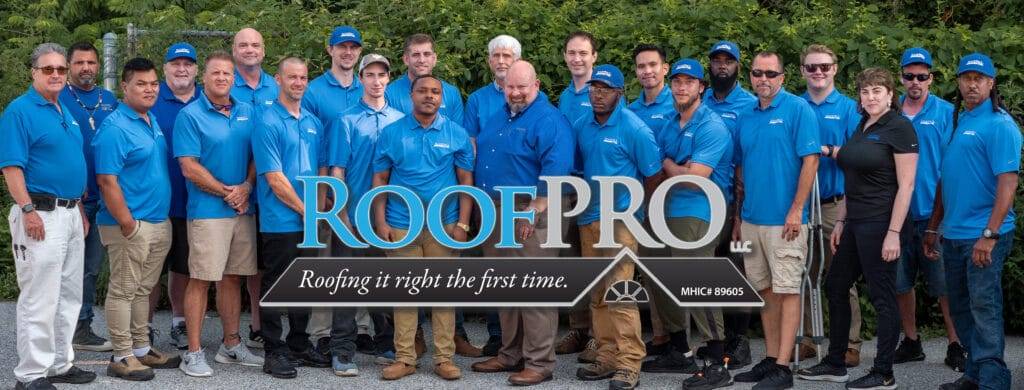If you notice stains inside your home, peeling paint, or a musty smell you just can’t place, your siding might be leaking. A leak isn’t just an inconvenience; it’s a major red flag. Water damage can spiral out of control quickly, leading to mold growth, structural issues, and significant repair costs. But don’t panic. With the right approach, you can stop leaky siding before it causes major damage.

What Causes Siding Leaks?
Siding is meant to protect your home from the elements. But when it fails, it can lead to leaking. Whether it’s poor installation, weather damage, or simply aging materials, moisture can find its way in. Here are the usual culprits:
- Cracks and Gaps: Even the tiniest cracks can let moisture seep behind your siding.
- Improper Installation: If it wasn’t installed correctly, moisture might be sneaking through unsealed joints or misaligned panels.
- Loose or Missing Panels: Wind, storms, or general wear can loosen panels, creating entry points for moisture.
- Worn-Out or Missing Caulking: Caulking is your siding’s first line of defense around seams and joints. If it’s cracked or missing, moisture will find its way in.
- Flashing Issues: Flashing around windows, doors, and roof edges directs rainwater away. If it’s damaged or missing, leaking is inevitable.
- Severe Weather: Heavy rain, snow, and ice can exploit weaknesses in your siding, especially if it’s already compromised.
Why Leaks Are Sometimes Misdiagnosed
Not every “siding leak” actually starts with the siding. In many cases, the real problem begins higher up, along the roofline, around windows, or even inside the gutter system.
When gutters clog or overflow, rainwater can spill over the edge and overwhelm the system instead of draining away properly. Once that happens, it often runs down the wall and shows up as stains, bubbling paint, or damp drywall inside your home.
Behind your siding is a waterproof layer called house wrap. The siding itself is meant to shed rainwater, while the house wrap acts as the true moisture barrier. When that wrap is torn, improperly installed, or missing altogether, moisture has a direct path into your home’s structure. Over time, this can lead to mold, wood rot, and insulation damage, all of which are far more expensive to fix than a simple repair.
The Role of House Wrap and Flashing in Waterproofing
Think of house wrap and flashing as the unsung heroes of your home’s defense system. You might not see all of the parts of your siding system, but they play a huge role in keeping moisture out of your home.
House wrap is a breathable yet water-resistant barrier installed beneath your siding. It allows moisture from inside your home to escape while blocking external moisture from getting in. If it’s damaged or missing, moisture can easily find its way behind the siding, leading to mold and wood rot.
Flashing is the thin metal (or plastic) material installed around windows, doors, and other openings to direct rainwater away. Without properly installed flashing, rainwater can run behind your siding, causing major headaches down the line.
If your home was built without house wrap (which is unfortunately common in older Maryland homes) or if your flashing is failing, you may need professional help to fix the issue.
Signs Your Siding Is Leaking
Sometimes, a leak is obvious. Other times, they’re sneaky. If you notice any of these signs, it’s time to take action. Here’s how to spot the problem early:
- Dark stains right below a gutter: this means the gutter is overflowing and could be overwhelming the siding.
- Windows and doors with no Z-flashing at the top. This is the metal that starts behind the siding and comes out over the top of the window.
- Stains inside your home, especially near walls and corners.
- Peeling paint or wallpaper due to moisture build-up, specifically around window frames.
- Mold or mildew growth, either outside or inside.
- Warped or buckled panels that no longer lay flat.
- A musty smell that lingers in certain areas.
- Visible gaps or cracks.
- Unexpected or sudden spikes in your energy bills.
Immediate Steps to Take When You Notice a Leak
A siding leak isn’t something to put off. The longer moisture sits behind it, the worse the damage gets. Here’s what to do:
- Find the Source: Check for gaps, cracks, or damaged panels.
- Inspect for Visible Damage: Look for peeling paint, swelling wood, or mold growth.
- Apply a Temporary Fix: Use waterproof caulk or sealant to close gaps while you arrange for a permanent repair.
- Call RoofPRO: For permanent and professional siding repairs, give us a call today.

How to Find the Source of a Leak
Our inspection starts inside your home so we can identify where the damage is showing up. That gives us a clear reference point when we move outside to track down the exact source of the leak. Inside, we look for stains, moisture buildup, and soft spots in the walls or ceiling to help narrow down the affected area.
Once outside, we start with the obvious signs, things like missing panels, damaged flashing, or gaps around windows and trim. If the problem isn’t visible, we’ll carefully remove sections to see what’s happening underneath. We look for rusty nails, torn or missing house wrap, and any areas where moisture could be sneaking in.
From there, we move upward and inspect everything above the leak, including
- Windows: checking for missing flashing tape or Z-flashing.
- Roof-to-siding transitions: looking for missing step flashing or J-channels that could direct water behind the siding.
- Gutters: checking for overflow or poor drainage that overwhelms the system.
- House wrap: ensuring it’s properly installed, taped at the seams, and free from gaps or tears.
- Wood surfaces: looking for stains, soft spots, or signs of rot.
- Fasteners: checking for rusted nails or exposed heads that allow moisture to enter.
Our goal is to confirm exactly where the moisture is entering before making any repairs so the issue is truly fixed, not just covered up.
How to Fix a Leak
Fixing a leak starts with identifying why it is leaking. Most problems come from missing house wrap, faulty flashing, or rainwater being directed behind the siding. Each issue requires a different approach to ensure the repair lasts.
Missing House Wrap
If the house wrap is missing or damaged, the only real solution is proper replacement. This process begins by removing enough siding to access the damaged area, which can sometimes mean taking off the entire wall. Once the wall is exposed, we install new house wrap and tape every seam to create a watertight barrier. Around windows and doors, we apply both flashing tape and Z-flashing to guide rainwater away from the wall. After the house wrap is sealed, new siding is installed to restore protection and appearance.
Missing Flashing Around Doors and Windows
Leaking near windows and doors often happens because of missing or failed flashing. To fix this, we remove the siding at least two feet out from the opening in all directions. The new flashing tape and house wrap are installed, tucking the lower section of wrap underneath the upper layer so that rainwater sheds correctly. Z-flashing is installed along the top of the window or door frame to push rainwater outward instead of allowing it to run behind the siding. Once everything is sealed and secure, the siding is reinstalled for a watertight finish.
Water Directed Behind the Siding at Roof-to-Wall Transitions
One of the most common and challenging leak areas is where the roof meets the wall. Step flashing in this section can sometimes direct rainwater behind the siding rather than away from it. To repair the issue, we remove the siding in that area, and in some cases, the gutter as well. Any rotted wood is replaced before installing new house wrap and sealing the seams.
In tighter corners where house wrap cannot fully reach, we use metal flashing along the wall to ensure rainwater drains away correctly. After that, we reinstall the siding and create a small slit near the bottom edge so that the roofing drip edge extends outward. This lets the rainwater flow safely over the siding surface instead of getting trapped behind it.
Each of these repairs requires careful work and attention to detail, but they are essential for protecting your home from future leaks and costly damage.

Exterior Siding Repair vs. Replacement
Should you patch the damage or start fresh with new siding? It depends.
- Repairing makes sense if the damage is limited to a small section, and the rest of the siding is in good shape. Replacing a few boards, fixing flashing, or reapplying caulk might be all that’s needed.
- Replacement is the better choice if you notice widespread warping, rot, or repeated leaking in multiple areas. If your siding is older and showing signs of wear, installing new siding could save you from constant patchwork fixes.
But remember, siding repairs aren’t as simple as slapping on a new coat of paint or applying a temporary sealant. They require a deep understanding of the materials, the installation process, and how moisture moves through the layers of your home’s exterior. Fixing a leak in your siding is not a weekend DIY project; it requires experience and expertise to get the job done right.
The Cost of a Siding Repair in Maryland
Maryland homeowners often wonder: How much will it cost for exterior siding repair services? The answer depends on the extent of the damage and the materials involved.
Typical Repair Prices:
- Small Repairs (caulking, sealing, minor panel replacement): $200–$600
- Moderate Repairs (replacing a section of siding, fixing house wrap): $700–$2,000
- Full Replacement (depending on material and home size): $7,000–$20,000+
Factors That Affect Cost:
- Extent of water damage: The longer the leak has been there, the more repairs will be needed.
- Siding material: Vinyl siding is more affordable, while fiber cement siding costs more.
- Labor & permits: Hiring an experienced contractor ensures quality work but comes with labor costs.
If you’re seeing signs of damage, it’s best to address the problem sooner rather than later to avoid even higher repair costs.
How to Keep Your Siding Leak-Free
Prevention starts with simple maintenance. Inspect your siding every spring and fall, especially after heavy storms. Keep caulking fresh around windows and trim. Clear gutters and downspouts to prevent overflow, and make sure landscaping doesn’t trap moisture against your home’s walls. RoofPRO also offers annual inspection plans to help you stay ahead of any leaking before it starts.
Choosing the Right Material to Prevent Leaks
Now, let’s talk about materials, because the right choice can make a world of difference. High-quality siding not only elevates your home’s curb appeal but also plays a crucial role in keeping water where it belongs: outside. Our team takes into account local factors such as humidity, seasonal rains, and even the specific materials popular in your neighborhood.
When you choose professional repair with RoofPRO, you’re also tapping into our extensive knowledge of siding materials.
- Vinyl Siding:
- Pros: Affordable, low maintenance, and can be installed with additional insulation.
- Cons: Can warp in unique sicarios where extreme temperatures are directed at the siding.
- Fiber Cement Siding:
- Pros: Durable, resistant to fire and termites, and excellent at withstanding harsh weather.
- Cons: Heavier and often requires professional installation for proper performance.
- Wood Siding:
- Pros: Natural, attractive, and can give an unmatched curb appeal.
- Cons: Requires regular maintenance, including sealing and painting, to prevent moisture damage.
- Aluminum Siding:
- Pros: Extremely durable, resistant to pests, and modern in appearance.
- Cons: Can dent easily and can be hard to replace if manufacturers stop making it.

FAQs About Leaking Siding
Costs vary based on the extent of damage. Small fixes can start around $300, while major siding replacements can run into the thousands.
At least once a year, typically in spring or fall. If you’ve had a major storm, it is probably worthwhile to have an additional siding inspection.
It depends. If the leak is from sudden damage (like a storm), insurance might cover it. If it’s from neglect or aging materials, probably not.
When to Call a Professional
If you’re noticing signs of a leak or just want to be proactive about your home’s maintenance, now’s the time to act. Reach out to RoofPRO for a free, no-obligation consultation. Our team is always ready to chat about your concerns, offer expert advice, and set up a plan that fits your schedule and budget.
How RoofPRO Can Help Fix and Prevent Leaks
When you choose RoofPRO, you’re not just getting a quick patch; you’re investing in a durable solution that stands the test of time. Our team has seen it all and knows exactly how to tackle even the most stubborn leak. With our expert repairs, you can rest easy knowing your home is in safe hands. Below is a quick overview of our siding inspection and repair process:
- Initial Consultation: We begin with a friendly, no-pressure consultation to understand your concerns. We listen closely to the issues you’ve noticed and discuss your home’s history.
- Detailed Evaluation: Our experts start by carefully examining every part of your system. We don’t just look at the obvious problem areas; we inspect corners, seams, and even the spaces behind your siding.
- Comprehensive Report: After the inspection, we compile a thorough report detailing our findings. This report not only highlights the current issues but also outlines steps you can take to prevent future problems.
- Tailored Repair Plan: Based on the inspection, we develop a repair plan that suits your home’s unique needs. We explain every step in plain language, ensuring you’re comfortable and informed about what’s ahead.
- Siding Repairs & Installation: With the plan in place, our skilled team gets to work. We use top-quality materials and proven techniques to repair and reinforce our work, ensuring that the fix isn’t just temporary.
- Final Quality Check: Once the repairs are completed, we conduct a final walk-through. This isn’t just a formality we double-check every detail to ensure that your home is secure and protected against future leaking.
Imagine having a professional guide who not only points out the problems but also explains them in plain language. That’s exactly what our inspections are all about. We provide clear, honest advice that empowers you to make informed decisions about your home.
Benefits of Choosing RoofPRO
Here’s why Maryland homeowners trust us:
- Local Expertise: We understand Maryland’s climate like the back of our hand. This means we’re well-versed in the challenges your home faces and know exactly which repair methods will stand up to local weather conditions.
- Reliable and Timely Service: We know that time is of the essence when it comes to protecting your home. Our team works swiftly and efficiently, ensuring your home is safeguarded as quickly as possible.
- Guaranteed Workmanship: With RoofPRO, you’re not just getting a repair; you’re getting a promise of quality. Our work is backed by warranties that give you peace of mind for years to come.
- Reputation: RoofPRO is certified by leading manufacturers, including CertainTeed, one of the most respected names in roofing and siding. We’ve also earned an A+ rating with the BBB.

Protecting Your Maryland Home from Damaged Siding
Siding leaks might start small, but they can lead to big problems. The key is catching them early, sealing gaps, and keeping up with maintenance on loose or damaged siding. Whether your home has vinyl, fiber cement, or cedar shake siding, every material needs the right care to stay watertight and beautiful. And if things ever get out of hand, RoofPRO has your back. Just give us a call. We’re here to keep your home’s shingles and siding working properly and looking great. From siding maintenance and repair to full replacement and installation, RoofPRO has you covered.
Article Updated October 30, 2025.

Author Bio
Tim Taylor – Owner & Founder of RoofPRO
Tim Taylor began his roofing career in 2003 and founded RoofPRO in 2004 with a mission to fix the poor workmanship that often causes roof leaks. With over 20 years of hands-on experience, he’s earned elite credentials like CertainTeed’s ShingleMaster Wizard certification, HAAG inspection certifications, and OSHA safety training. His expertise in leak repair, flashing repair, and post-storm restoration has made RoofPRO one of Maryland’s most trusted roofing companies. Tim continues to lead with the same principle that built his reputation—roof it right the first time

